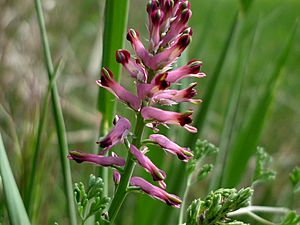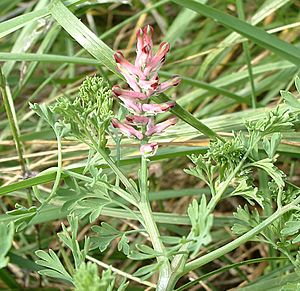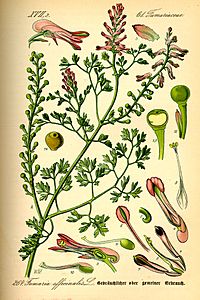Common fumitory facts for kids
Quick facts for kids Common fumitory |
|
|---|---|
 |
|
| Scientific classification | |
| Genus: |
Fumaria
|
| Species: |
officinalis
|
The Fumaria officinalis, also known as common fumitory or earth smoke, is a type of flowering plant. It is an annual plant, meaning it lives for only one growing season. This plant belongs to the poppy family, called Papaveraceae. It is the most common kind of Fumaria plant found in Western and Central Europe.
Contents
What it Looks Like
This plant is an herbaceous annual, which means it has soft stems and lives for one year. It grows upright but also scrambles along the ground. Its stems can be about 10 to 50 centimeters (4 to 20 inches) long.
The plant has thin, green leaves. Its small, pink flowers appear from April to October in the northern parts of the world. In the UK, they bloom from May to September. Each flower is about 7 to 9 millimeters (0.28 to 0.35 inches) long. They have two "lips" and a small spur. The plant often has more than 20 flowers on each spike, sometimes up to 60!
After flowering, it produces a small, round fruit called an achene. This fruit holds one seed. The plant contains natural chemicals like alkaloids, potassium salts, and tannins. It is also a source of fumaric acid.
Plant History
The common fumitory was first officially described by a Swedish botanist named Carl Linnaeus. He wrote about it in his important book, 'Species Plantarum', in 1753.
There are two known types of this plant, called subspecies:
- Fumaria officinalis subsp. cilicica
- Fumaria officinalis subsp. wirtgenii
Why it's Called "Fumitory"
The name "fumitory" comes from words meaning "smoky" or "fumes." This is because its flowers have a see-through color that looks like smoke. Also, its leaves have a slightly gray-blue color, which can look like smoke rising from the ground, especially when there's morning dew.
People in the early 1200s already called this plant fūmus terrae, which means "smoke of the earth." Even two thousand years ago, ancient writers like Dioscorides and Pliny the Elder wrote about it. They said that rubbing the plant's sap into the eyes could make them water, just like strong smoke does.
Its Greek name is kapnos, also meaning "smoke." The name fumewort is now mostly used for a different group of plants called Corydalis. This is because some Corydalis plants look similar to fumitory.
Where it Grows
The common fumitory is naturally found in warm areas of North Africa, Europe, and parts of Western Asia.
It grows in many places, including:
- North Africa: Canary Islands, Algeria, Egypt, Libya, Morocco, and Tunisia.
- Western Asia: Caucasus region, Cyprus, Iraq, Israel, Lebanon, Siberia, Syria, and Turkey.
- Europe: From Belarus and Ukraine in the east to Britain, France, Portugal, and Spain in the west. It also grows in countries like Germany, Italy, Greece, and Sweden.
Traditional Uses
People in Europe started using this plant as a medicine in the late Middle Ages. However, it was known even in ancient times. In the 1600s, some believed it was good for the eyes.
Traditionally, it was often used to help with digestion and to act as a diuretic, which helps the body get rid of extra water. Different folk traditions also used it for things like constipation, skin problems, and as an eyewash for conjunctivitis.
Since 1963, it has been sold as a herbal medicine in France. Today, herbal products from this plant are sold legally in countries like Austria, Germany, France, and Spain.
Some studies on animals suggest it might help with unusual bile flow. It also seems to have an antispasmodic effect, which means it might help relax muscles in the upper digestive system. While these effects are promising, more research is needed to fully prove how well it works in humans.
It is important to know that this plant should only be used under the guidance of an expert, like a doctor or a trained herbalist. This is because its effects on children, pregnant women, or the elderly are not fully known.
Plant Chemicals
The common fumitory plant contains natural chemicals called isoquinoline alkaloids. Two of these are protopine and allocryptopine. Scientists have studied these chemicals to understand how they affect human cells.
Images for kids
See also
 In Spanish: Palomilla para niños
In Spanish: Palomilla para niños






